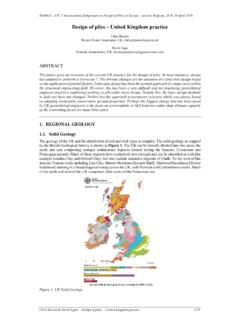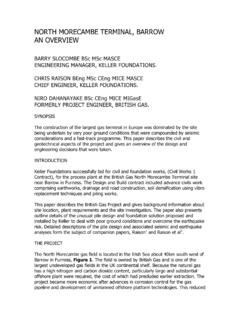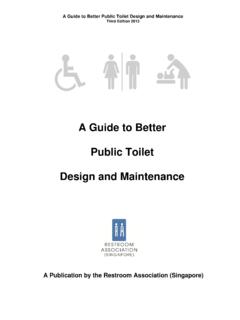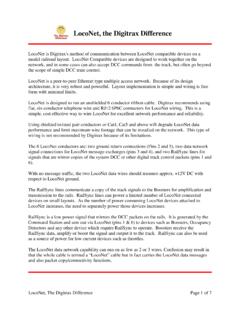Transcription of North Morecambe Terminal, Barrow: pile design for …
1 North Morecambe Terminal, Barrow: pile design for seismic conditionsC. A. Raison,BEng,MSc,CEng,MICE,MASCE&Very poor ground conditions and soils thatwere susceptible to liquefaction to depthsof up to 20 m beneath the site were majorproblems for the construction of thelargest natural gas processing terminal inEurope. Foundations were required tocater for liquefaction and the need todesign for de ned magnitudes of earth-quake. An innovative foundation solutioncombining deep vibrocompaction withshort cast-in-place piles driven into thetreated soils was adopted as both cost- andprogramme-e ective. The design and buildproject included preliminary site prepara-tion and civils work comprising earth-works, drainage and road contract started in September 1991and was completed by October 1992, withthe process plant programmed to be onstream by October 1994. This paperpresents details of the unusual pile designand foundation solution proposed to over-come the earthquake : piles foundations;seismic engineeringIntroductionKeller Ground Engineering successfully bid forcivil and foundation works for the process plantat the British Gas North Morecambe Terminalsite in Barrow.
2 The design and build projectincluded preliminary site preparation and civilswork comprising earthworks, drainage androad construction, soil densi cation usingvibroreplacement techniques and piling contract started in September 1991 andwas complete by October 1992. A generalizeddescription of the works and the constructionactivities is given by Ground information about the overallproject including the o shore platform andpipeline is given by Juren2and For the UK, historical records show thatthe Morecambe Bay area has been subject to arelatively high level of seismic of the critical nature of the site and itssensitive location, British Gas carried outseismic risk assessments as part of the earlyproject feasibility studies4,5andduringtheconceptual design concluded thattwo levels of earthquake should be applied tothe design of the process plant and assessment also highlighted the very realpossibility that liquefaction could occur in thenatural soils to depths up to 20 m below groundand foundations were required to allow for paper presents details of the unusual piledesign and foundation solution proposed toovercome the earthquake risk.
3 Detailed resultsof extensive on-site pile testing will form thesubject of a future site and geology3. The North Morecambe Terminal site islocated to the North of the existing British GasSouth Morecambe Terminal about 2 km south-east of Barrow-in-Furness (Fig. 1). The site isapproximately 750 m long in the North southdirection and about 250 m wide, bounded by thecoast to the west and undulating pasture landto the east (Fig. 2).4. Before development, the majority of the20 ha (50 acre) site comprised three formersettlement lagoons containing saturated pul-verized fuel ash (PFA) (Fig. 3). The PFA was awaste product from the adjacent coal- redRoosecote power station. The North and southPFA lagoons were generally at a higher levelthan the central lagoon, with better drainageresultinginacrustof was at 12 m OD (Ordnance Datum) in thenorth lagoon and 10 m OD in the south the lower central lagoon, the PFA wasextremely soft with water at the ground surfacetypically at 7 m Extensive site investigation, includingboreholes and static cone penetration tests(CPTs), revealed ground conditions beneath thePFA to comprise very loose silty gravellyalluvial sand over more dense glacial sands,with glacial till and sandstone at depth.
4 Groundconditions were locally variable and simpli ca-tions were necessary for design purposes. Atypical geological section is shown in Fig. The PFA extended down to a level ofabout 4 m OD. It was usually extremely softwith standard penetration test (SPT)Nvaluesas low as 2 blows/300 mm (Fig. 5). Parts of thenorth and south lagoons had been formed tohigher levels where some degree of pozzolanicreaction had occurred within the upper were generally higher. Particlesize grading of the PFA indicated a sandy siltwhich was often Immediately beneath the PFA werealluvial deposits up to 7 m thick whichvaried between a soft silty clay with bandsChris Raison,formerly ChiefEngineer, KellerGround Engineering,Coventry149 Proc. InstnCiv. EngrsGeotech. Engng,1999,137,July,149 163 Paper 11822 Written discussioncloses 18 December1999 Manuscript received2 December 1994;revised manuscriptaccepted 19 April1999of peat in the upper levels, becoming a looseto medium dense silty, occasionally gravellyand clayey sand at depth.
5 The sands hadmeasuredNvalues ranging between 5 and30 blows/300 mm (Fig. 5).8. The glacial soils were extremely mixed,encountered generally as a uvioglacial sand,or sand and gravel, over lacustrine glacial lakeclay and glacial till. The sands often containedthin layers of clay up to 0 5 m thick. The glacialsands typically hadNvalues varying between5 and 30 blows/300 mm as shown in Fig. for the lake clay wereabout 15 20 blows/300 mm, whileNvalues inexcess of 50 blows/300 mm were recorded inthe glacial Sandstone bedrock of Triassic age wasfound at about720 m Groundwater was perched within thePFA generally at about 7 8 m OD and close toground level within the lowest part of thecentral lagoon. In the natural soils, ground-water varied between 4 m OD and 7 m problem11. Foundation design and constructionfaced technical problems due to extensive PFAlagoons underlain by loose granular had to cater for soil liquefactionand the need to design for de ned magnitudesof Seismic risk assessments carried out aspart of the early project feasibility studies werere ned following extensive geotechnical 6 Two levels of earthquake werespeci ed for the design .
6 General operatingneeds required a foundation solution able towithstand a 1-in-500-year design earthquake,equivalent to a Richter scale event of 5 25 at adepthof10kmwithanepicentreat15kmdistanc e. Certain selected critical plant itemsor shutdown structures (Fig. 6) had to survive a1-in-10 000-year seismic event, equivalent to 6 0on the Richter The seismic risk assessment anticipatedaccelerations of 0 05 g and 0 20 g at bedrockwith ampli cation due to soil conditions toabout 0 08 g and 0 28 g at the ground studies used these values to establishthe potential for soil liquefaction following themethods of Seed and Idress,7and Seedet was carried out using both charac-teristic and probabilistic methods based on SPTand CPT design pro ,10 Studies concludedthat the loose alluvial and glacial sands couldliquefy to depths of up to 20 m below groundduring a 0 20 g earthquake, and that the PFAwould liquefy during both levels of solution14.
7 The foundation problems were complexand the period available for outline design andtendering was limited. The scheme put forwardwas based on the use of vibrodensi cationtechniques and short cast-in-place piles driveninto the treated soils. This is illustrated sche-matically in Fig. 7. Although vibro groundtreatment had been used many times in the pastand was a well-proven technique to prevent soilThe siteExistingsouthterminalIsleofWalneyMor ecambeBayRampside01 2 Scale: kmBarrow-in-FurnessFig. 2. View looking North showing the site bounded by the existing SouthMorecombe Terminal to the south and Roosecote power station to thenorth, with Barrow-in-Furness beyond150 Fig. 1. Site locationplanRAISON0100 Scale: mHillsideSouthlagoonNorthlagoonCentralla goonForeshoreSea wall100 10 20 Reduced level: mODSand fill anddrainage layerAlluvial sand withclay layersGlacial sandwith gravelGlacial sandGlacial clayGlacial tillSandstone bedrockPFAFig.
8 4. Typical geological section15105 5 10 15 20 30 250 Level: mOD0204060 SPT N value: blows/300 mmPFAA lluvial sandGlacial sand with gravelFig. 5. Plot of standard penetration test resultsCritical plant items 0 28 gNon-critical plant 0 08 gSeismic protection area0100 Scale: m151 Fig. 3. Site layoutplanFig. 6. Critical plantitems and seismicprotection areaNORTH MORECAMBETERMINAL: PILE design liquefaction, this was the rst time that groundimprovement had been used in this mannertogether with piling. The result was an innova-tive and more e cient solution, with theimproved density of the soil giving a betterfoundation for piles and major savings inlength, pile section and Vibroreplacement was not a suitabletechnique to eliminate liquefaction of the verysoft PFA ll. Following the recommendations ofthe seismic risk assessment, a partial dig andreplacement scheme with drainage was pro-posed to control groundwater.
9 This wouldprevent liquefaction during the low-level 0 05 gdesign earthquake, and had the added advan-tage of providing a very stable working plat-form for the vibro and piling Advantages of the dual system solutionto the client included an assured constructionprogramme, due to linking two low-cost high-production techniques, and a more predictableseismic behaviour. The approach was exible,enabling additional low-cost piles to beinstalled to cater for design changes withoutthe need for more vibro stone design requirements17. During a 1-in-500-year earthquake,e ective stress site response computationsshowed that liquefaction of the natural soilswas was indicated by the smallchanges in pore pressure computed for the0 05 g design earthquake (Fig. 8). Liquefactionof the very soft PFA ll was a seriouspossibility but could be prevented by a partialcut and replacement scheme. The remainingPFA was totally unsuited for foundations, andpiling was required to transfer structural loadsthrough the weak PFA to the underlying piles had to withstand the earthquakeloadings and control shakedown settlement orlateral movement without disrupting normaloperation of the process It was not possible to prevent lique-faction of the PFA during a 1-in-10 000-yearseismic event, but site response computationsshowed that treatment by vibrodensi cationtechniques would prevent liquefaction of thenatural soils (Fig.)
10 9).19. Piles installed for non-critical plant werenot required to survive. However, piles for allcritical plant items had to survive su cientlyintact to limit vertical and lateral movementfrom shakedown, and to cater for the e ects ofincreased pore water pressures and the dynamicmotion of the plant items. Piles had to providesupport continuity through the partially tototally lique ed PFA, cope with reduced lateralsupport from the soil, and deal with possiblehorizontal lurch movements up to 100 Post-earthquake consolidation of thelique ed soil was also expected which wouldresult in major downdrag loads on the pileshafts. Throughout the seismic event, pileshad to maintain su cient axial load supportcapacity and limit structural movements. Pileswere not required to be reused following a0 20 g design The client's primary requirement forshutdown structures was that damage belimited to avoid release of any inventory gasinto the atmosphere.










